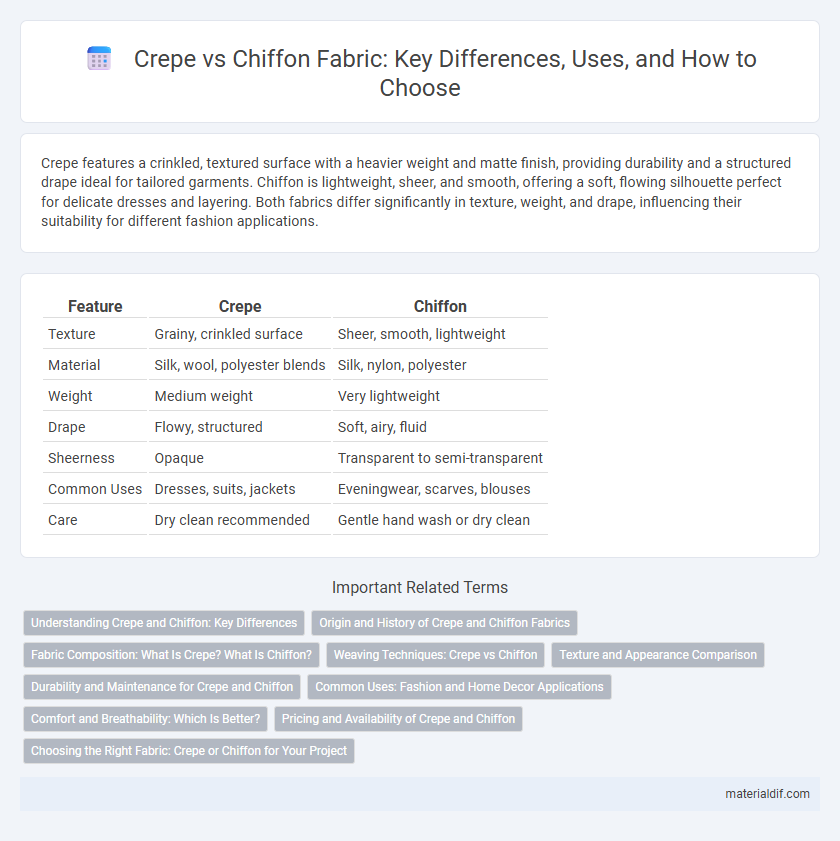Crepe features a crinkled, textured surface with a heavier weight and matte finish, providing durability and a structured drape ideal for tailored garments. Chiffon is lightweight, sheer, and smooth, offering a soft, flowing silhouette perfect for delicate dresses and layering. Both fabrics differ significantly in texture, weight, and drape, influencing their suitability for different fashion applications.
Table of Comparison
| Feature | Crepe | Chiffon |
|---|---|---|
| Texture | Grainy, crinkled surface | Sheer, smooth, lightweight |
| Material | Silk, wool, polyester blends | Silk, nylon, polyester |
| Weight | Medium weight | Very lightweight |
| Drape | Flowy, structured | Soft, airy, fluid |
| Sheerness | Opaque | Transparent to semi-transparent |
| Common Uses | Dresses, suits, jackets | Eveningwear, scarves, blouses |
| Care | Dry clean recommended | Gentle hand wash or dry clean |
Understanding Crepe and Chiffon: Key Differences
Crepe fabric features a textured, crinkled surface created through a special weaving technique, offering a heavier weight and matte finish ideal for structured garments. Chiffon is lightweight, sheer, and smooth with a slightly rough feel due to its balanced plain weave, commonly used for flowing, delicate clothing. Key differences lie in texture, weight, opacity, and drape--crepe provides a denser, opaque fabric with more body, while chiffon delivers a transparent, airy material perfect for layering and softness.
Origin and History of Crepe and Chiffon Fabrics
Crepe fabric, originating from the French word "crepe," dates back to the 15th century and was initially made from silk with a distinctive twisted yarn that creates its characteristic crinkled texture. Chiffon, derived from the French term for "rag" or "cloth," emerged in the 18th century and traditionally utilized silk fibers to produce a lightweight, sheer fabric with a slightly rough feel. Both fabrics have evolved over centuries, becoming staples in fashion due to their unique textures and luxurious origins tied to European textile history.
Fabric Composition: What Is Crepe? What Is Chiffon?
Crepe fabric is typically made from wool, silk, or synthetic fibers like polyester, featuring a distinctive crinkled texture due to the high-twist yarns in its weave. Chiffon is a lightweight, sheer fabric primarily composed of silk, nylon, or polyester, characterized by its delicate, smooth, and slightly rough surface with a fine mesh weave. Both fabrics differ significantly in texture and drape because crepe uses tightly twisted fibers for a textured feel, while chiffon employs loosely twisted yarns creating a soft, flowing finish.
Weaving Techniques: Crepe vs Chiffon
Crepe fabric is created using a unique weaving technique involving tightly twisted yarns that produce a pebbled, textured surface, enhancing its durability and drape. Chiffon is woven with a plain weave using fine, evenly twisted yarns, resulting in a lightweight, sheer, and soft fabric ideal for flowy garments. The distinct weaving approaches directly influence the tactile quality and appearance, with crepe offering a grainy texture and chiffon exhibiting a smooth, translucent finish.
Texture and Appearance Comparison
Crepe fabric features a crinkled, grainy texture with a matte finish, creating a slightly rough feel and a heavier drape. Chiffon offers a smooth, sheer texture with a delicate, translucent appearance, producing a lightweight and airy flow. Texture differences make crepe ideal for structured garments, while chiffon suits soft, flowing designs.
Durability and Maintenance for Crepe and Chiffon
Crepe fabric is known for its durability due to its tightly woven fibers and slightly rough texture, making it more resistant to wear and tear compared to chiffon. Maintenance of crepe requires gentle hand washing or dry cleaning to preserve its texture, while chiffon is more delicate, prone to snags and tears, and typically needs careful hand washing with mild detergent or professional dry cleaning. Both fabrics benefit from low-heat ironing or steaming to avoid damage, but chiffon demands extra caution to maintain its lightweight, sheer quality.
Common Uses: Fashion and Home Decor Applications
Crepe fabric is widely used in fashion for elegant dresses, blouses, and suits due to its textured finish and excellent drape, making it ideal for formalwear and office attire. Chiffon is favored for evening gowns, scarves, and bridal wear because of its lightweight, sheer quality that provides a flowing, delicate appearance suitable for sophisticated and romantic styles. In home decor, crepe is often utilized for curtains and upholstery that require durability and a subtle texture, while chiffon is primarily chosen for decorative sheer curtains and lightweight drapes that add an airy, soft ambiance.
Comfort and Breathability: Which Is Better?
Crepe fabric offers a textured surface with moderate breathability, making it comfortable for extended wear in cooler climates. Chiffon, known for its sheer, lightweight weave, excels in breathability and provides superior comfort in hot and humid conditions. When choosing between crepe and chiffon, chiffon is generally better for breathability, while crepe offers more structure with moderate comfort levels.
Pricing and Availability of Crepe and Chiffon
Crepe fabric generally offers a more affordable price point compared to chiffon due to its simpler weaving process and broader availability. Chiffon, made from finer fibers like silk or polyester, often commands higher prices and can be less accessible in certain markets. Both fabrics are widely available, but crepe is more common in mass-produced garments while chiffon is favored in luxury and formal wear.
Choosing the Right Fabric: Crepe or Chiffon for Your Project
Crepe fabric offers a slightly heavier texture with excellent drape and wrinkle resistance, making it ideal for structured garments or projects requiring durability. Chiffon is lightweight, sheer, and delicate, perfect for flowy designs and layering that demand a soft, ethereal appearance. Selecting between crepe and chiffon depends on the desired garment structure, texture, and the visual effect needed for your project.
Crepe vs Chiffon Infographic

 materialdif.com
materialdif.com